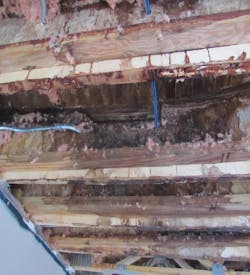Boom Town Is Falling Down
The housing boom of the early 2000s was a legendary party followed by a massive, national hangover. And while the remodeling market is in full recovery-mode today, there are still plenty of headaches left over from that historic fiesta.
One of the biggest is something you don’t see reported on very often. Currently, hundreds of thousands of people across the country are discovering that their brand new homes were poorly built and now need costly repairs. In most cases, the repairs can be made, but issues remain. Just ask Franco Fournier, in Encinitas, Calif.
“We bought our home from the developer as part of a new subdivision back in 2003,” the homeowner says. “Within 14 months we started seeing our floor buckling. It was because there was water in the foundation. Then we started seeing water damage in the downstairs bedroom. We tried to contact the builder, but he never returned our calls.”
Just a little north in Newport Beach, homeowner Allan Hilldebrand suffered from a similar problem. “I moved here with my wife and we bought our new home as part of large subdivision,” Hilldebrand says. “The first year, our hardwood floors started warping, and that winter our windows started to leak. They were installed incorrectly and they used the cheapest material there was. Now we’re noticing hundreds of small cracks in the walls and around the foundation. The house is worth so much more than when we bought it, so all of those things were fixed, but it does point to a bigger problem.”
Minneapolis homeowner Berta Stoecker was horrified when her new home started to show leaky windows and wall moisture as well. But that wasn’t all. “Within a very short time frame, we had a mold problem,” Stoecker says. As a result of the mold and concerns for her family’s health, the Stoeckers were forced to relocate—at their own expense. The experience is still difficult for her to discuss. “I just want to forget the whole thing and move on with my life,” she says.
Often, by the time the damage is discovered, framing has rotted. This roof didn’t actually leak. The water came from rising dampness from the masonry walls, which were very porous. The moisture collected between the roofing material and the plastic vapor barrier. Photo: Don Van Cura
Boom and Bust
In 1995, more than 500,000 single-family homes were built in the U.S., according to the National Association of Home Builders. Just 10 years later, that number had nearly doubled. It was a party like the industry had never seen before.
When examining statistics of single-family housing starts over the same period, 1995 to 2005, an interesting trend begins to appear. The areas that experienced the highest level of building activity have also experienced the highest incidence of construction flaws.
When looking at the regions of the U.S., the South witnessed a staggering 47 percent of total housing starts during that time. The West came in second place with 24 percent, while the Midwest tallied up 18.9 percent of building activity. The Northeast saw the fewest number of new homes built during that period, with 9.5 percent.
While it’s impossible to connect these building hot spots with specific construction defects, it is plausible to conclude that where extensive development exploded, so too did faulty construction and poor craftsmanship.
Water, Water Everywhere
One of the key factors was a lack of qualified builders. “It got to be like if you could fog a mirror, you could get a job working construction. It was absolutely crazy,” says Brad Grossman, remodeling expert and owner of Free Framers, of St. Petersburg, Fla. “There was such an influx of work that a lot of contractors didn’t know what to do. They had to hire people to finish the jobs, but a lot of these workers were just unqualified.”
The housing boom, in other words, resulted in a labor shortage where finding quality construction professionals became as hard as hitting a winning lottery number. Grossman adds, “There was a lot … I mean a lot of really poor craftsmanship in Florida during that time.”
Grossman, a second-generation remodeler and framer, says that the most common problems he sees are poor tile installation and sloppily installed windows. Close behind is substandard stucco application and the use of cheap materials.
“I see huge amounts of water damage caused by poor construction,” he says. “Applying stucco isn’t hard, but there is a right way to do it and a wrong way. If it’s not done correctly, you will have water damage. End of story.”
Indeed, water damage is the most common problem reported from multiple sources around the country. This is because there are many errors that result in moisture going where it doesn’t belong, and only a few ways to prevent it. “It’s devastating to me to see how many contractors use plastic vapor barriers without proper ventilation,” says Don Van Cura, president of Chicago-based Don Van Cura Construction. “You can’t do that because the water never leaves. It’s trapped.”
The problem is similar to placing a teaspoon of water in an inflated balloon, Van Cura explains. No matter how hot the day or cold the night, that water will never evaporate. It’s stuck inside the balloon, where it will eventually form a microclimate. “[In the building envelope] that moisture then penetrates the insulation and rots out the roof truss,” he says. “It can be an extremely costly repair, but it has to be done.”
Twelve hundred miles south in Texas, experts are seeing a different problem, but essentially the same result: water damage.
Mark Eberwine, construction engineer and principal of Five-Star Home Inspections, in San Antonio, explains that his state is still suffering from the hangover effects of the construction boom. As an expert witness for the State of Texas, Eberwine is an outspoken advocate for professional construction and superior craftsmanship.
“There are a host of problems that can be directly connected to the construction boom,” Eberwine says. “We have many subdivisions where the slab is exposed and stucco was poorly applied. The water hits the drainage plane and is absorbed into the walls. You can’t get it out. Once it’s trapped, water will start rotting the wall plates. Unfortunately, Texas home builders have a dismal record of constructing foundations that properly support the walls, ceilings, and other substructure components.”
[LEFT] Frequently, when homeowners first see water marks or drips on their ceiling, there has already been a lot of damage. Plastic vapor barriers retain moisture, which is absorbed by the framing and loose-fill insulation.
[RIGHT] A good tool for determining if moisture is present is the infrared camera because evaporating moisture shows up on thermal images as cool spots. When the drywall and plastic were removed from the ceiling in this photo, water poured out of the roof trusses. Photos: Don Van Cura
Who’s to Blame?
Remodelers don’t exclusively blame unskilled labor for these construction defects. Many also attribute the construction problems to city and municipal inspectors.
A report filed by the New Jersey State Commission of Investigation in 2005 found that one of the biggest contributors to faulty building practices in the Garden State was a lack of municipal inspection support.
“Builders were building at a rate that inspectors simply couldn’t keep up with,” says Joseph R. Mariniello, commissioner for the New Jersey State Commission of Inspection, and a practicing attorney. “They just could not get effective and timely inspections.”
Home inspection expert Eberwine agrees. “I personally saw one city inspector with 7,000 applications for foundation construction projects,” he says. “That is literally an impossible number to inspect. As a result, the inspector would stamp the application and hope for the best.”
Whatever the root causes or subsequent problems associated with the building boom, there is one very clear bright spot in otherwise dark skies. Today, professional remodelers are busier than ever. From Georgia to Illinois, down to Texas and out to California, remodeling pros are working at full pace repairing faulty construction problems and improving the homes that were poorly built just 10 or so years ago. In some cases, this trend has resulted in a remodeling boom.
“Most of my business comes from doing repairs,” Van Cura says. “It’s heartbreaking to have to tell a new-home owner that his house needs considerable remodeling work because of poor construction, but that’s the result of big builders doing everything bigger, faster, and cheaper. I would estimate that at least 50 percent of the business we do is for repair work.”
In Florida, Grossman feels the same way. He started his construction business in 2007 specifically to address the problems of poor craftsmanship. “Why did I start my business at a time when every other builder was going under? I was making a statement that there is a need for professional construction,” he says. “I spend a fair amount of my time repairing all the things that were built during the boom. But as a result of that, I’m getting a lot of custom homes, exterior jobs, and a fair share of interior remodeling jobs as well.”
As a result, Grossman’s business has grown to an annual sales volume of $3.5 million, and he employs 25 people. “This feels like a brand new boom,” he says. “But, I tell my clients, ‘This time we either do it correctly, or we don’t do it at all.’”
Attention to Detail
When most of us picture a chemist, we imagine a wealth of knowledge and demanding education. However, for Don Van Cura, owner of Don Van Cura Construction, every remodeling professional needs to apply that same level of awareness and schooling to excel in today’s industry.
“My father was a physician, and I was going to become a biochemist. It’s funny how life turns out. I ended up in the trades, but I never lost my desire to learn,” Van Cura says.
With the same attention to detail that a marine biologist needs to master the life sciences, Van Cura applied to learning every facet of construction. Today, he is one of the most respected remodelers in Illinois, past president of his National Association of the Remodeling Industry chapter, and a Certified Remodeler, Certified Kitchen and Bath Remodeler, and Certified Lead Carpenter.
“I am a professional craftsman and have to keep on top of current technology,” Van Cura says. “Look, I still have my Miller Falls miter box, but these days I use a laser-guided saw. Today’s professional has to take continuing education seriously and attend as many continuing ed courses as possible.”
Van Cura not only preaches this philosophy, he practices it as well. He is proud of his connection to industry associations and enrolls in or teaches as many seminars as time allows. “It’s a golden experience to have industry associations,” he says, “and I take those relationships very seriously.”
In addition to being an expert witness for the State of Illinois, Chicago Police Department, and individual homeowners, Van Cura is also the recipient of numerous remodeling awards.
A Different Perspective
For Steve Gustafson, president of Nautilus General Contractors, headquartered in San Diego, with branch offices in Irvine and Santa Maria, Calif., Scottsdale, Ariz., and Las Vegas, currently the best description of his company is as a re-construction and repair contractor and expert. The reason: “Since 2002,” he says, “we have basically specialized in fixing construction problems and defects in homes, commercial buildings, and properties, on projects that range from $25,000 to $8 million.”
From extensive foundation work for single-family homes to large-scale cooling tower repairs in high-rise condos, Nautilus Construction is a leader in this market. “I really enjoy the problem-solving aspect of the process,” Gustafson says. “I ask myself, ‘What is the deficit in the design or as-built condition, and what are the alternatives for fixing the problem?’”
Gustafson is particularly well-equipped to see construction defects from a variety of perspectives. Not only is he a licensed general contractor with nearly 30 years of industry experience, he’s an engineering contractor and registered architect who also attended the Kellogg School of Management at Northwestern University.
Once I had some business experience,” he says, “I started working with my best friend’s father, who ended up being my mentor. He was handling insurance repairs [and] the more I worked, the more construction defects started popping up, and we were hired to fix them. It was kind of a round-about way to start, but here I am.”
Gustafson also serves as an expert witness for the industry. He’s been deposed more than 300 times and has testified as the lead expert in more than 30 trials.
“Typically, I’m used as an expert witness for homeowners who are trying to get construction companies to pay for problems associated with faulty building practices,” he says. “In my experience, roughly two-thirds of problem construction projects I see are defective. Rarely do the solutions that developers provide to owners solve the problems inherent in the project. Fortunately or unfortunately, our [company’s] growth has followed the growth of boom-time construction.”
Today, Nautilus Construction employs 60 general contractors, engineers, architects, and craftsmen throughout California, Arizona, and Nevada.
“When I first started, we did a ton of foundation repair work,” Gustafson says. “This was a really big deal in California. Now the industry is building foundations with better reinforcing. Also, when I started, the big builders in Arizona never used flashing around windows. Now, that’s considered the standard. I think it’s true to say that we contributed to better industry practices.”




